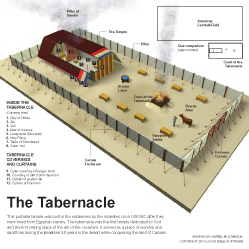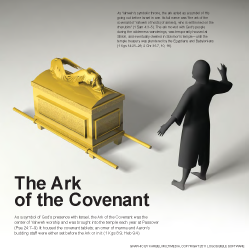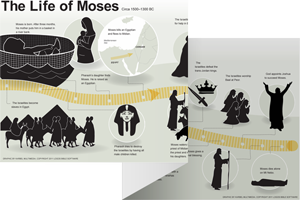25:1–9 The next major section of Exodus (Exod 25–31) relays God’s instructions to Moses for building the tabernacle, Israel’s portable tent shrine, where the presence of God would dwell, beginning with Israel’s time in the wilderness and ending with the reign of King Solomon. These instructions are carried out in chs. 35–39, and the tabernacle is assembled and consecrated in ch. 40. This passage in vv. 1–9 serves as the introduction to the instructions, starting with the call for the Israelites to voluntarily bring the materials for the project. |
25:2 a contribution The Hebrew term used here, terumah, refers to personal property that is set apart for sacred use.
25:3 gold and silver and bronze The value of these metals (listed in descending order) reflects their sanctity: the higher the value, the greater the sanctity. Iron is not included, perhaps because its association with warfare and death rendered it inappropriate for the holiness of the tabernacle (see 1 Kgs 6:7; 1 Chr 28:3). Another reason iron may not be included is that the tabernacle construction occurred before iron became a regular commodity.
 Tabernacle Materials and Equipment Table
Tabernacle Materials and Equipment Table
25:4 blue, purple, and crimson yarns These were among the most costly dyed yarns of the ancient Near East. As with the metals in Exod 25:3, the yarns are listed in order of value and therefore sanctity within the tabernacle. Holy ground is not common ground; it is extraordinary and therefore must be treated as such.
fine linen The Hebrew term used here, shesh, derives from an Egyptian term denoting cloth of very high quality.
25:5 fine leather The Hebrew term used here, tachash, refers to some sort of animal skins. Here it is mentioned in parallel with leather made from ram skins, suggesting it simply refers to a type of leather. The term is almost always used for the protective material covering the tabernacle furnishings in transit. In Ezek 16:10, tachash is a material that sandals can be made from.
acacia wood A fragrant and waxy wood from the acacia plant. This plant has feathery leaves and a thin trunk, which makes large pieces of wood difficult to come by in most species. The acacia plant is used as a source of food and perfume, and also as an astringent in medicine. In ancient Egypt, the acacia plant was associated with the “tree of life” in several myths. Today, it is classified as an “exotic” wood and is related to blackwood (Africa) and koa (Hawaii), all of which are particularly dense and difficult to work with.
25:6 oil The intended uses for the items listed in this verse are explained later: oil for the lamps (Exod 27:20–21), anointing oil, incense (30:22–38; 37:29).
25:7 onyx stones The Hebrew term used here, shoham, refers to some kind of gemstone. It may refer to onyx or to lapis lazuli. The same kind of stone is used in the ephod of the priest (28:9).
ephod and the breast piece These garments will be explained in more detail in ch. 28. The ephod is the priestly robe and the breastpiece is a metal adornment with twelve precious stones, one representing each tribe of Israel.
is the priestly robe and the breastpiece is a metal adornment with twelve precious stones, one representing each tribe of Israel.
25:8 a sanctuary The Hebrew word used here, miqdash, comes from the verb qadash (which may be rendered “to be holy” or “make holy”) and refers to an enclosed sacred space designated for the presence of Yahweh (compare 33:15).
25:9 the pattern of The Hebrew term used here, tavnith, is also used to describe the design of the temples of Solomon (1 Chr 28:11) and Ezekiel (Ezek 43:10; spelled as tokhnith). The tabernacle was to be an earthly replica of a divine archetype, a cosmic sanctuary where Yahweh dwelled.
the tabernacle The Hebrew term mishkan (which may be rendered “dwelling”) refers to the Israelites’ portable sanctuary used during their journey to the promised land. See note on 26:1.
25:10–22 The Ark of the Covenant, as described in vv. 10–22 and elsewhere, is comparable in design to the thrones associated with deities and, sometimes, royalty throughout the ancient Near East (e.g., 1 Kgs 10:18–20). The defining features are the seat atop the ark itself, and the cherubim that flank either side. The account of the ark’s is construction in located in Exod 37:1–9. |
25:10 an ark of The Hebrew word used here, aron, refers to a storage chest or box of varying size. The word is commonly used to refer specifically to the ark of the covenant, which symbolized Yahweh’s presence among the Israelites.
The ark of the covenant |
two and a half cubits The measurement from the tip of the fingers to the elbow. A cubit is roughly 18 inches.
is roughly 18 inches.
25:11 pure gold That is, the most prized and precious material. For additional information, see note on v. 3.
25:12 four gold rings Allowed the ark to be carried using two wooden poles (vv. 13–15). Once it was constructed, the ark could not be touched by human hands (vv. 15; Num 4:15; compare 2 Sam 6:6–7). This rule was enforced even after the ark was placed in the temple (1 Kgs 8:8).
25:15 will be With the poles always in place, it could be moved at a moment’s notice.
25:16 testimony The people have already received one set of laws that were written down by Moses (Exod 24:4), but Moses has yet to receive the tablets inscribed by Yahweh (24:12; 31:18; 32:19; 34:1, 28–29). The ark’s primary function is to house these tablets.
25:17 an atonement cover of The lid of the ark, on which the blood of the sacrifice was sprinkled on the Day of Atonement (Lev 16). Its dimensions precisely match those of the ark itself. Whereas the ark was made of acacia wood overlain with gold, the lid was made of solid gold. It is the most holy object mentioned in the ot, because this was the spot from which Yahweh spoke (Exod 25:22).
itself. Whereas the ark was made of acacia wood overlain with gold, the lid was made of solid gold. It is the most holy object mentioned in the ot, because this was the spot from which Yahweh spoke (Exod 25:22).
The Hebrew noun for the lid of the ark, kapporeth—literally translated “covering”—is from the verb kaphar, meaning “to atone” or “to cover.” Similarly yom kippur is the Day of Atonement—the one day of the year when the high priest enters the Holy of Holies (Most Holy Place) where the ark is located and sprinkles it with blood for the sins of the people. The translation “mercy seat” is based on how the Septuagint and the Vulgate (the Greek and Latin versions of the Old Testament, respectively) handled the Hebrew word kapporeth. Instead of the literal translation “covering,” these ancient translations interpreted the noun term to mean “mercy” and the slab as “seat.” This interpretation is based on Num 7:89 (compare Exod 25:22), which describes Yahweh’s voice emanating above the kapporeth, and the phrase that Yahweh is “enthroned above the cherubim” (1 Sam 4:4; 2 Sam 6:2; 1 Chr 13:6; 2 Kgs 19:15; Isa 37:16; Pss 80:2; 99:1). The kapporeth was the place where God met Moses in the tabernacle (Num 7:89). The kapporeth was, in effect, the throne of Yahweh on earth. |
25:18 cherubim of The spiritual beings called cherubim (a plural form in Hebrew) were typically depicted in the ancient Near East with a composite of human, bird, and bovine features (compare Ezek 1:5–10; 10:1–15). The term is related to the Akkadian word for a guardian of the divine throne (karibu/kuribu).
25:22 I will meet you Meaning Moses, to whom Yahweh is giving these instructions (compare Exod 30:6, 36; Num 7:89; 17:4).
25:23–30 The plan for the table for bread is similar to that of the ark of the covenant (Exod 25:10–22; 37:1–9) in that it is made of acacia wood, overlain with gold, and carried via four rings and two poles. The use of gold and acacia wood is described in more detail earlier in the chapter (see note on v. 3; note on 23:5). The table goes by other slightly different descriptions in the ot, as well (2 Chr 29:18; Lev 24:6). |
25:28 the table will be carried Like the ark (Exod 25:12–15), the table is made to be carried with poles, not touched.
25:29 ladles This is one of two places where incense offerings are made within the tabernacle. There is also an altar of incense described in 30:1–10; 37:25–29.
pitchers Similar to a pitcher, a flagon is a large container in which drink is served, usually with a handle and spout.
will be poured Libations were a common form of divine offering in the ancient Near East, usually consisting of the finest wine available.
25:30 the bread of presence The table held 12 loaves of bread, symbolizing the 12 tribes of Israel (Lev 24:5–9). The loaves were displayed in two equal rows. They were not touched during the week, but on the Sabbath they were eaten by priests (Lev 24:9) and replaced with 12 fresh loaves.
25:31–40 The golden lampstand (menorah in Hebrew) becomes the symbol of the divine presence in early Judaism, because of its association with light and goodness (e.g., Zech 4). |
25:31 a lampstand of The Hebrew word used here, menorah, refers to a lampstand with seven branches that was stationed on the tabernacle’s southern side (Exod 26:35; 40:24). According to Lev 24:1–4, the lamp was to be kept burning continually. Little else about it is known.
25:32 six branches The lampstand’s shape resembles a tree. Since the tabernacle was to be the cosmic domain of Yahweh, the menorah (see note on Exod 25:31) tree likely symbolized the tree of life from Eden.
25:33 almond-flower The reference to almond blossoms supports the tree-of-life symbolism of the lampstand. The almond flower symbolized life and its renewal (e.g., Jer 1:11–12; compare Eccl 12:5). The Hebrew term for almond blossoms, shuqedim, is related to the verb shaqad, which may be rendered “to be watchful.” Thus the almond flowers may symbolize Yahweh’s watchfulness. In Zechariah’s vision of a lampstand, its seven lights represent the eyes of Yahweh (Zech 4:2, 10).
a bud The Hebrew word used here, kaphtor, is an architectural term (compare Amos 9:1; Zeph 2:14), describing the top of a column. The ornamentation style of these columns may have come from Crete, since the Hebrew term for that island is kaphtor.
since the Hebrew term for that island is kaphtor.
25:34 lampstand See note on Exod 25:31.
25:37 seven lamps Since the menorah or lampstand has seven lights, it is used in Judaism to commemorate the Sabbath—the day of rest on the seventh day of the week—in line with the fourth commandment (20:8–11). The candles are lit on Friday evening at sundown and placed in a prominent location, such as a window or mantle, as a reminder of the seven days of creation (20:11) and slavery in Egypt (Deut 5:15).
25:38 snuffers These enabled one to adjust the wicks once they became too short, without burning oneself, while the lamps were still lit.

|
About Faithlife Study BibleFaithlife Study Bible (FSB) is your guide to the ancient world of the Old and New Testaments, with study notes and articles that draw from a wide range of academic research. FSB helps you learn how to think about interpretation methods and issues so that you can gain a deeper understanding of the text. |
| Copyright |
Copyright 2012 Logos Bible Software. |
| Support Info | fsb |
 Loading…
Loading…




 Ark of the Covenant
Ark of the Covenant 